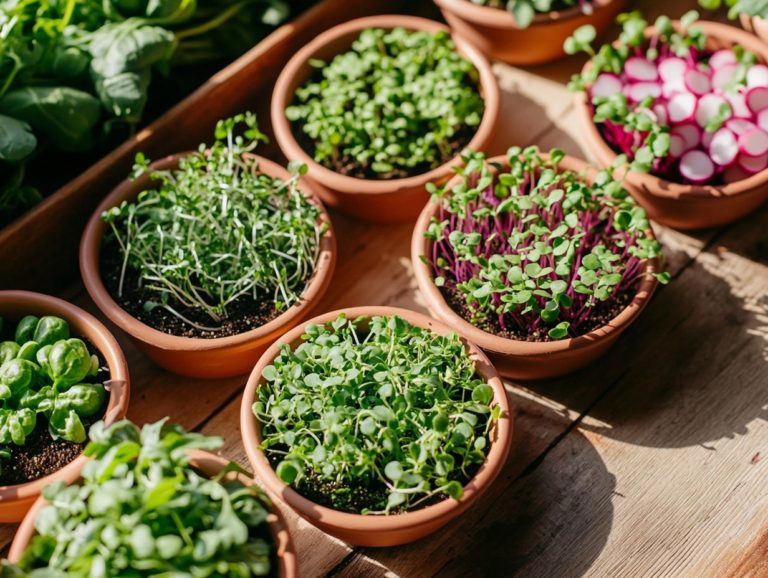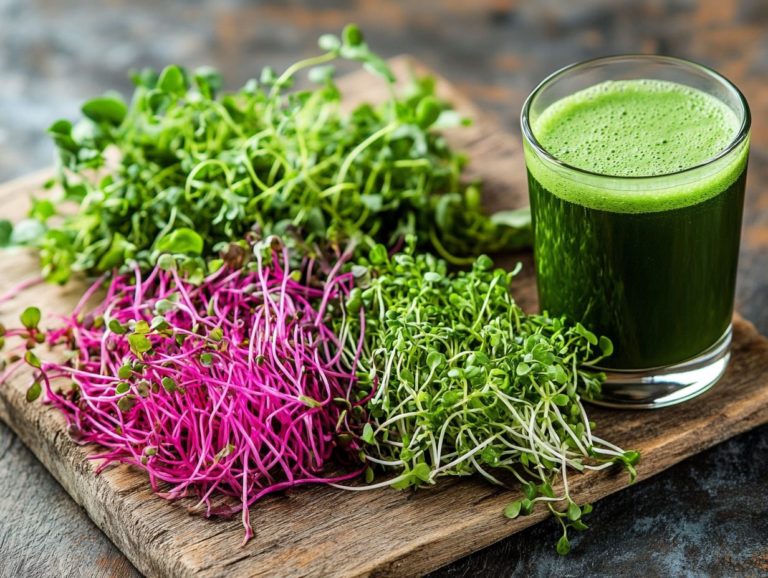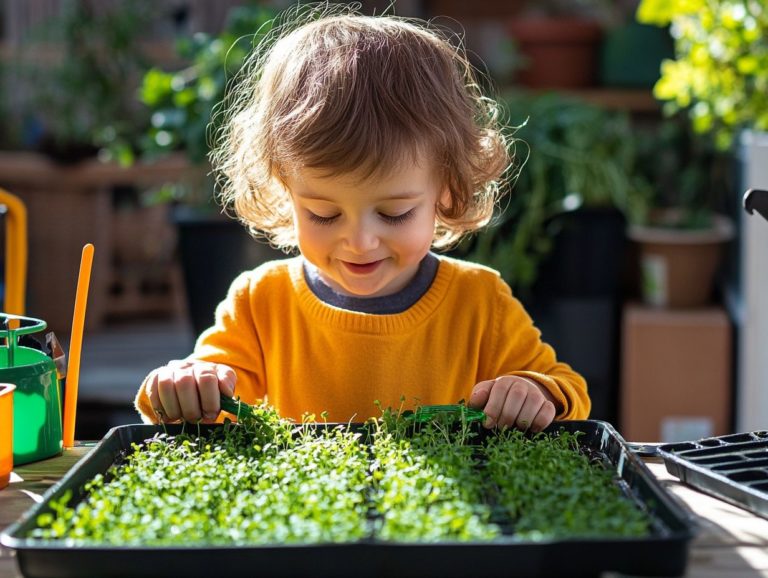How Often Should I Fertilize Microgreens?
Microgreens are tiny, nutrient-packed powerhouses! They have captured the attention of the culinary world. Mastering their fertilization is crucial for unlocking their full flavor and health benefits.
Understanding how to nourish these delicate greens can profoundly impact their growth and yield.
This article covers the essentials of fertilizing microgreens. You will learn about the best fertilizers, including organic liquid options, and how to spot over- or under-fertilization.
You will also discover alternative methods, including DIY fertilizers. You ll have all the tools you need to cultivate a thriving microgreen garden, whether in a greenhouse or through hydroponics.
Contents
Key Takeaways:
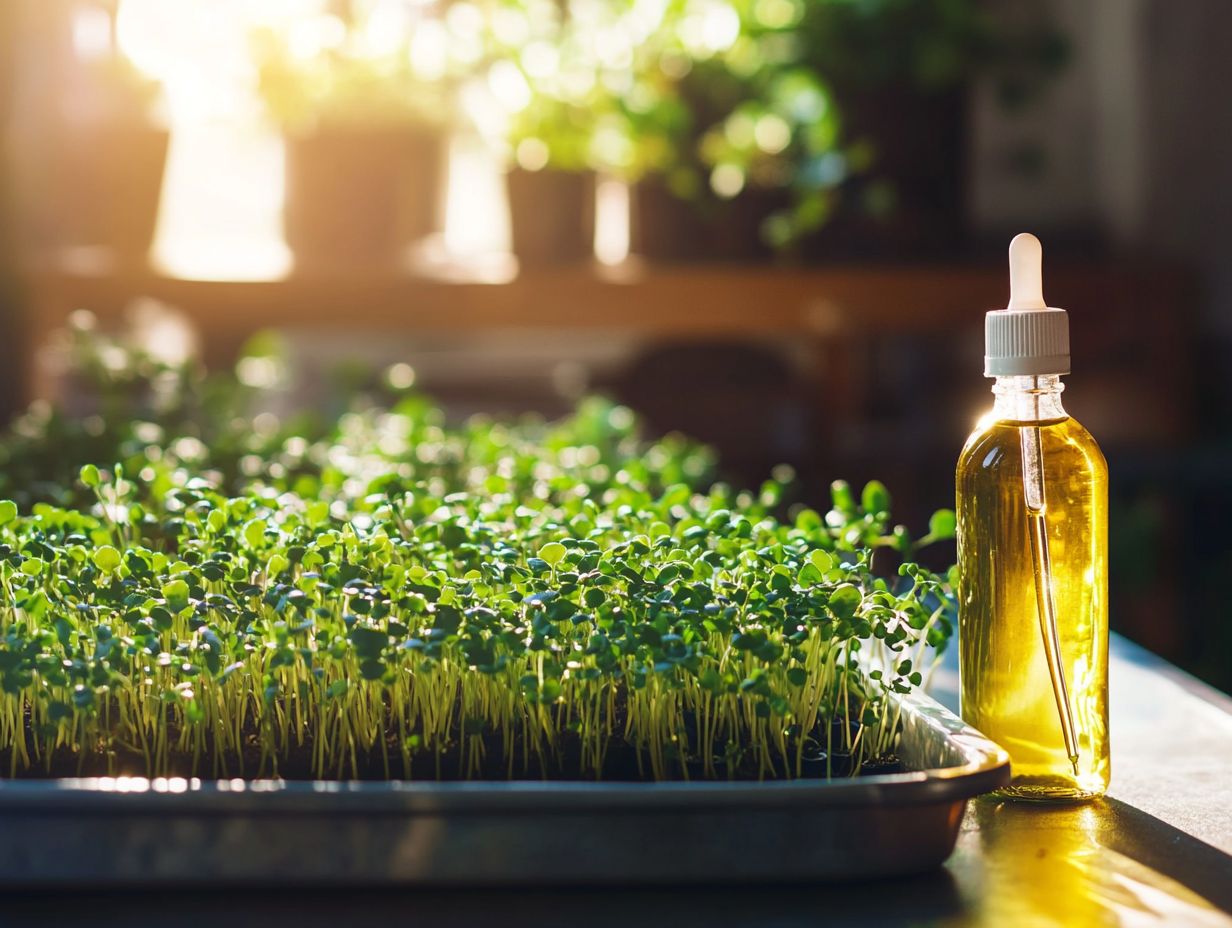
- Fertilizing microgreens is essential for healthy growth.
- The frequency of fertilization depends on the type, growth stage, seed size, and environment.
- Watch for signs of over- or under-fertilization to prevent damage.
Understanding Microgreens and Fertilization
Microgreens are nutrient-dense young plants. They are harvested right after their first leaves unfold.
These tiny greens have gained popularity in cooking and health. Growing them can be a rewarding journey, whether in a greenhouse, through hydroponics, or using high tunnels.
Fertilization is vital for their robust growth. Applying fertilizers like FloraGro and Azomite can significantly improve the nutrient profile of your microgreens.
What are Microgreens?
Microgreens are young, edible plants that can be harvested within 7 to 21 days after germination. They are packed with flavor and nutrients!
Among various types, Amaranths shine with vibrant colors and nutty flavors. They make a fantastic addition to salads and smoothies.
Kale microgreens are rich in vitamins A, C, and K. Their slightly peppery taste enhances soups and gourmet dishes.
Radish microgreens add a spicy kick, perfect for sandwiches or tacos. These mini powerhouses boost culinary creations while providing numerous health benefits!
Importance of Fertilization for Microgreens
Fertilization is key for the growth of your microgreens. It supplies essential nutrients that enhance their flavor, color, and vitality.
With many fertilizers available, pick the right one for your crops! Organic liquid fertilizers are excellent for those wanting to grow nutrient-dense plants.
Incorporating compost into your growing medium enriches the soil. This mix fosters healthier plants and vibrant microgreens that tantalize the senses!
Factors to Consider for Fertilizing Microgreens
When fertilizing microgreens, consider key factors for optimal growth. The type of microgreen you re cultivating is crucial, as different species like Basil, Tomatoes, and Mustard have unique nutritional needs.
The growth stage of your plants is also important. Along with environmental conditions like soil temperature and moisture, these factors help determine the right fertilizer type and frequency of application.
Type of Microgreen
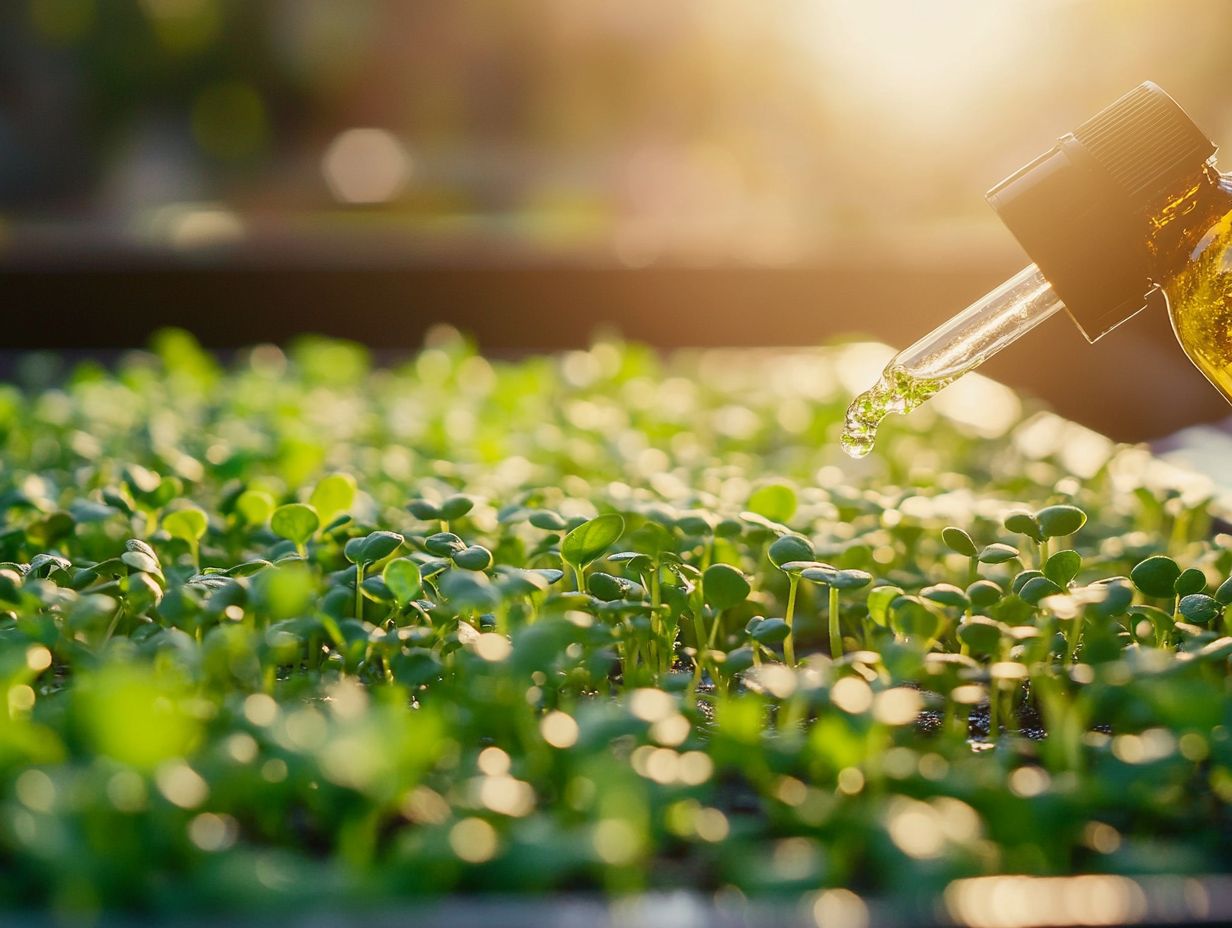
Different types of microgreens vary not only in flavor and appearance but also in their specific nutrient requirements and optimal fertilization methods.
For example, you ll find that kale microgreens flourish with nitrogen-rich fertilizers. This nutrient boost supports vigorous leaf growth and elevates their rich, earthy flavor to new heights.
On the other hand, parsley microgreens renowned for their vibrant green hue and delightful aroma thrive best with a balanced nutrient mix. This mix fuels consistent growth and respects their delicate nature!
Chervil, celebrated for its subtle taste, demands careful attention to moisture levels and nutrient balance. This ensures healthy sprouts during their early growth stage.
By understanding these diverse needs, you enhance your fertilization process and optimize the flavor and health benefits of these tiny nutritional powerhouses.
Growth Stage
The growth stage of microgreens is important for determining the quantity and type of nutrients you need. Seedlings require different fertilization approaches compared to more mature plants.
During their initial phase, young microgreens thrive on light fertilization to support their careful growth. As they progress, their nutrient demands shift, showing why a well-balanced approach that includes essential vitamins and minerals is necessary.
Keep a close eye on nutrient levels to avoid stunted growth and unlock the incredible flavors of your microgreens! By adjusting your fertilization techniques, you not only enhance the health of your microgreens but also pave the way for a more bountiful harvest.
Understanding these evolving requirements helps you maximize your yields and ensures optimal quality throughout the lifecycle of your crops.
Environmental Conditions
Environmental conditions, such as soil temperature and humidity levels, play a crucial role in determining the effectiveness of fertilization in microgreens, significantly impacting their overall growth and health.
In hydroponic systems, where plants grow in nutrient-rich water instead of soil, the absence of soil presents unique pathways for nutrient absorption. This often results in remarkably quicker growth rates. However, it’s essential for you to meticulously monitor the environmental controls in hydroponics, as factors like pH and electrical conductivity can dramatically influence nutrient availability.
Conversely, soil-grown microgreens depend heavily on the organic matter and microorganisms found within their substrate. The ideal soil temperature for these plants typically hovers between 65 F and 75 F, a critical range that facilitates efficient nutrient uptake and boosts root development.
When soil temperatures dip below this range, your plants may struggle to absorb essential nutrients effectively, leading to slower growth and potential deficiencies. This scenario calls for a tailored fertilization strategy that accommodates these variations, ensuring your microgreens thrive.
Recommended Fertilization Frequency
Determining the ideal fertilization frequency for microgreens is crucial for maximizing their growth and yield, especially as they transition through various growth stages. It’s essential to strike a harmonious balance between supplying sufficient nutrients and steering clear of the dangers of over-fertilization, which can obstruct the development of your microgreens.
Typically, applying organic liquid fertilizers at regular intervals usually every 7 to 10 days can encourage optimal growth rates while keeping your plants healthy and vibrant.
General Guidelines
Fertilizing microgreens starts with knowing their growth needs. Consistently applying nutrients is crucial!
In the early stages when seedlings begin to show, use a mild liquid fertilizer made from natural ingredients every two weeks. As they mature around the two-week mark switch to weekly feedings to meet their growing nutrient demands.
It s important to consider specific microgreen varieties, like basil or radish, as each has unique nutrient needs. A common dilution ratio for liquid fertilizers is one tablespoon per gallon of water; this keeps the mixture gentle for delicate roots.
Apply this mixture gently at the base of the plants to provide nutrients while preserving the soil structure and protecting the seedlings from damage.
Specific Recommendations for Different Microgreens by Jordan Freytag
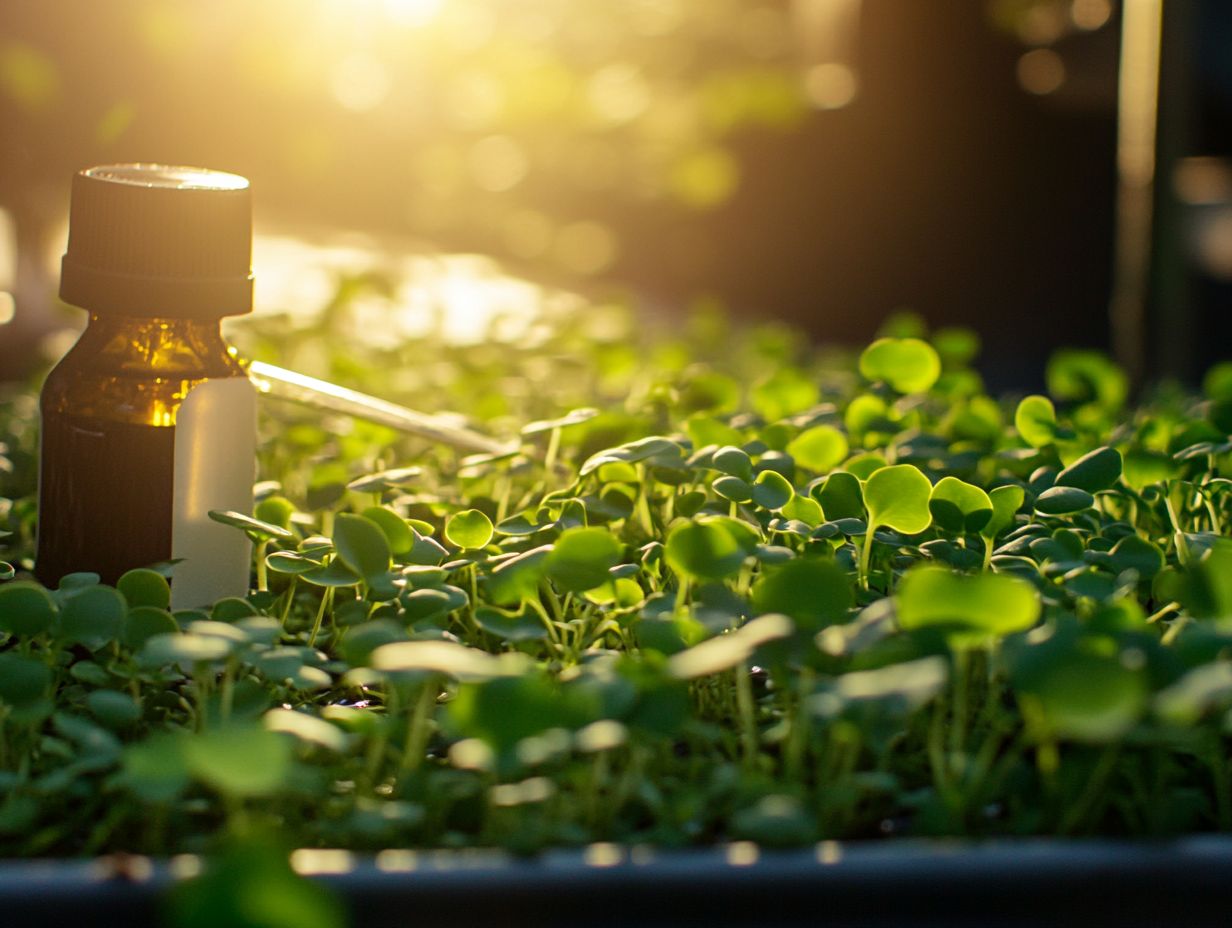
Specific recommendations for fertilization vary among different microgreen plants. Each type has its own unique nutrient requirements that must be met for optimal growth.
Understanding these specific needs helps ensure each variety thrives. For example, basil flourishes with a balanced fertilizer that promotes lush leaf formation, while kale benefits from a nitrogen-rich option that enhances its robust foliage.
Radish microgreens prefer a lower nutrient mix during their early growth to prevent overly rapid leaf development. By adjusting your fertilization practices based on the microgreens’ growth stage and current environmental conditions like temperature and light exposure, you’ll see a noticeable boost in nutrient absorption and overall yield. Additionally, understanding how often to harvest microgreens can further enhance your growing success!
Signs of Over- or Under-Fertilization
Recognizing the signs of over- or under-fertilization is important for anyone growing microgreens. Nutrient imbalances can lead to poor plant health and stunted growth, so stay alert to catch any signs early!
If you notice symptoms like yellowing leaves or sluggish growth, your plants may not be receiving optimal nutrient levels. Conversely, if you see leaf burn or wilting, it could signal excessive fertilization.
This requires a thoughtful reassessment of your fertilization strategy to ensure robust and healthy growth.
Identifying and Addressing Issues
Identifying and addressing issues related to over- or under-fertilization in microgreens is essential for their health and maximizing yield.
Observe visual symptoms such as yellowing leaves or stunted growth, as they can signal a nutrient imbalance. Soil testing is a reliable method for pinpointing these deficiencies or excesses, providing data to guide your corrective actions.
If the soil test shows nutrient excesses, cut back on the frequency and amount of fertilizer. If a deficiency is detected, supplementing with well-balanced organic fertilizers can restore balance to the growing medium, promoting robust plant development.
Alternative Fertilization Methods
Exploring alternative fertilization methods opens a world of options for you as a microgreen grower. It allows you to enhance plant health and yield without solely depending on commercial fertilizers.
From organic choices to DIY fertilizers, you have many ways to provide essential nutrients to your microgreens. Using natural sources like compost or foliar sprays promotes growth while elevating the quality and flavor of your harvest.
Organic Options
Organic options for fertilizing microgreens present a refined and sustainable approach that nurtures healthy plant growth.
This method is environmentally conscious and elevates the nutritional quality of your microgreens.
These methods enrich the soil, fostering a vibrant ecosystem in your garden. Various organic liquid fertilizers, such as compost tea (a nutrient-rich liquid produced by steeping compost in water) or fish emulsion (a liquid fertilizer made from fish waste), deliver essential nutrients like nitrogen, phosphorus, and potassium all crucial for robust microgreen development.
Embracing composting techniques, whether hot or cold, allows you to create rich organic matter that can be blended into soil or used as a top dressing.
By harnessing these natural resources, you can cater to a diverse array of microgreen varieties, ensuring they thrive while minimizing your environmental footprint.
DIY Fertilizers
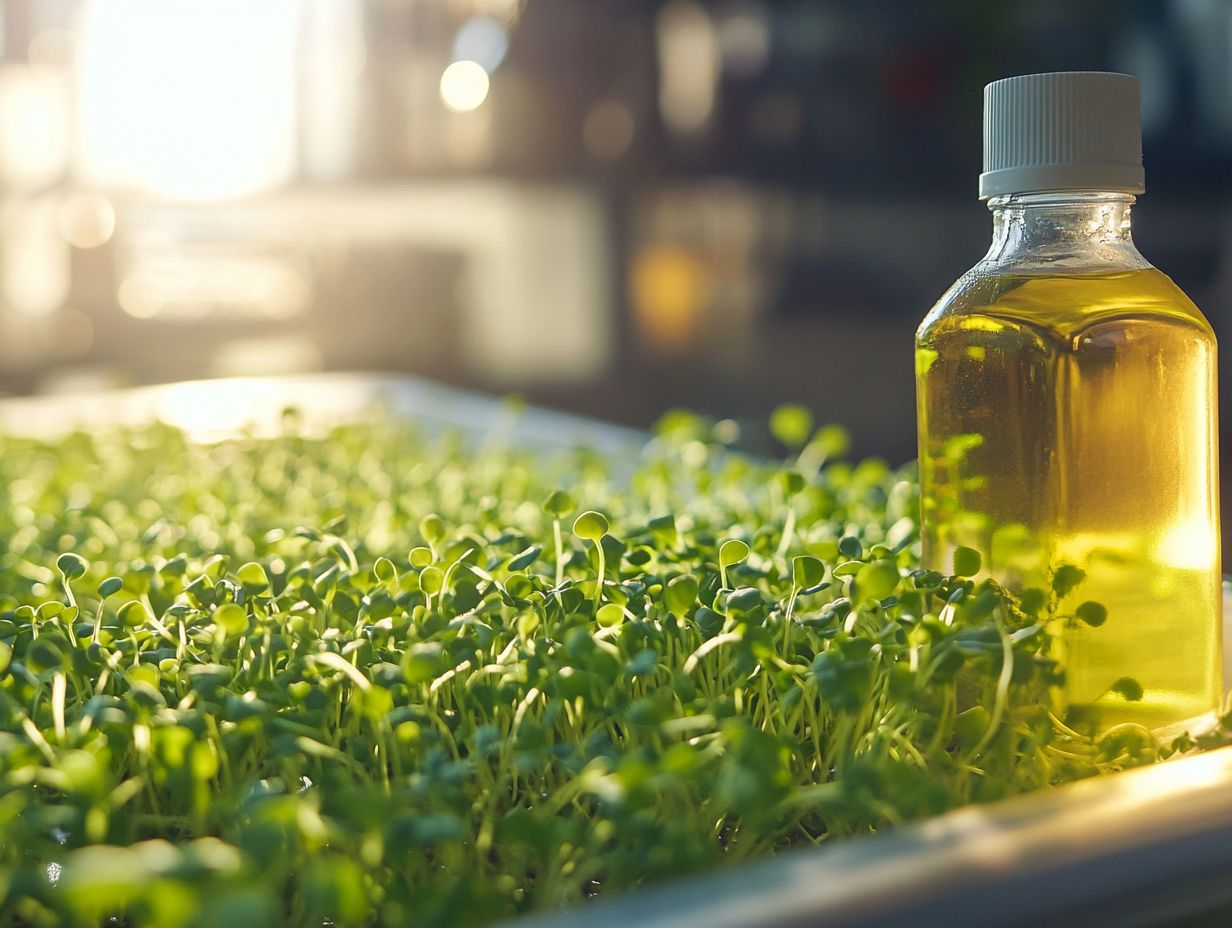
Making your own fertilizers puts you in control of your plants’ nutrition! You can create customized nutrient solutions tailored specifically to the unique needs of your microgreens.
By understanding the nutrient content of various ingredients think banana peels for potassium, coffee grounds for nitrogen, and eggshells for calcium you can craft the ideal blend that supports the growth stages of these delicate plants.
Start by gathering your chosen materials and chopping them into smaller pieces to maximize their surface area, which enhances nutrient release.
Next, combine these organic components in a compost bin or jar, allowing them to decompose over a few weeks. When it s ready, dilute the mixture with water before using it.
This homemade fertilizer approach boosts the vitality of your microgreens and reduces waste, making it a sustainable gardening practice that reflects your commitment to the environment. Get started with organic fertilizers today and watch your microgreens flourish!
Frequently Asked Questions
How often should I fertilize microgreens?
Fertilize your microgreens every 1-2 weeks for the best results! The frequency depends on the growing method, type of fertilizer used, and the stage of growth.
Can I over-fertilize my microgreens?
Yes, it is possible to over-fertilize microgreens. Over-fertilization can cause nutrient burn, stunted growth, and even death of the plants. It s important to follow the recommended dosage and frequency stated on the fertilizer package.
What type of fertilizer is best for microgreens?
Organic fertilizers such as compost, worm castings, and fish emulsion are often recommended for microgreens as they provide a balanced mix of nutrients. However, synthetic fertilizers can also be used if applied carefully and in the correct amounts.
Do I need to fertilize if I am using potting soil with added nutrients?
If you are using potting soil with added nutrients, you may not need to fertilize as frequently. However, it is still recommended to fertilize at least once during the growth cycle to ensure your microgreens have enough nutrients for optimal growth.
When should I stop fertilizing my microgreens?
You should stop fertilizing your microgreens a few days before harvesting to ensure the plants are free of any residual fertilizer. This will prevent any potential health risks from consuming excess fertilizer.
Can I make my own fertilizer for microgreens?
Yes, you can make your own organic fertilizer for microgreens using compost, worm castings, or other natural ingredients. However, it is important to properly research the nutrient ratios and application methods to ensure your microgreens receive the necessary nutrients for healthy growth.

